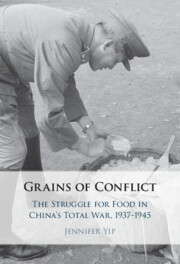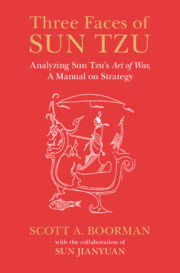Refine search
Actions for selected content:
69 results
Chapter 3 - Junctions
-
- Book:
- Railway Infrastructure and the Victorian Novel
- Published online:
- 12 August 2025
- Print publication:
- 28 August 2025, pp 70-100
-
- Chapter
- Export citation

Grains of Conflict
- The Struggle for Food in China's Total War, 1937–1945
-
- Published online:
- 23 August 2025
- Print publication:
- 31 July 2025
Introduction to volume III
-
-
- Book:
- The Cambridge History of War
- Published online:
- 18 July 2025
- Print publication:
- 14 August 2025, pp 1-52
-
- Chapter
- Export citation
8 - Fortification and siege warfare
-
-
- Book:
- The Cambridge History of War
- Published online:
- 18 July 2025
- Print publication:
- 14 August 2025, pp 205-230
-
- Chapter
- Export citation
11 - The military in Safavid Iran, 1501–1736
-
-
- Book:
- The Cambridge History of War
- Published online:
- 18 July 2025
- Print publication:
- 14 August 2025, pp 283-308
-
- Chapter
- Export citation
22 - The United States from Independence to the war with Mexico, 1776–1848
-
-
- Book:
- The Cambridge History of War
- Published online:
- 18 July 2025
- Print publication:
- 14 August 2025, pp 530-551
-
- Chapter
- Export citation
15 - Warfare in early modern Africa, c. 1450–c. 1850
-
-
- Book:
- The Cambridge History of War
- Published online:
- 18 July 2025
- Print publication:
- 14 August 2025, pp 387-408
-
- Chapter
- Export citation
3 - Ottoman wars and military transformation, 1453–1826
-
-
- Book:
- The Cambridge History of War
- Published online:
- 18 July 2025
- Print publication:
- 14 August 2025, pp 98-121
-
- Chapter
- Export citation
Introduction
-
- Book:
- Grains of Conflict
- Published online:
- 23 August 2025
- Print publication:
- 31 July 2025, pp 1-21
-
- Chapter
- Export citation
Chapter 18 - Small Trading Circuits and Micro-Logistics in Pericapitalist Markets
- from Part IV - Markets in Motion: Places and Spaces
-
-
- Book:
- Market Studies
- Published online:
- 22 November 2024
- Print publication:
- 21 November 2024, pp 294-314
-
- Chapter
- Export citation
Chapter 16 - Hannibal and Scipio
-
- Book:
- Hannibal and Scipio
- Published online:
- 05 September 2024
- Print publication:
- 26 September 2024, pp 337-368
-
- Chapter
- Export citation
16 - Hannibal and Scipio: The Military Comparison
-
- Book:
- Hannibal and Scipio
- Published online:
- 05 September 2024
- Print publication:
- 26 September 2024, pp 337-368
-
- Chapter
- Export citation
Chapter 10 - Common Themes and General Considerations across Mass Gathering Event Types
-
-
- Book:
- Mass Gathering Medicine
- Published online:
- 11 April 2024
- Print publication:
- 18 April 2024, pp 120-143
-
- Chapter
- Export citation
Towards an Energetics of Class: Comparing Energy Protests in India and the United States
- Part of
-
- Journal:
- Comparative Studies in Society and History / Volume 66 / Issue 3 / July 2024
- Published online by Cambridge University Press:
- 01 April 2024, pp. 528-556
-
- Article
-
- You have access
- Open access
- HTML
- Export citation

Three Faces of Sun Tzu
- Analyzing Sun Tzu's Art of War, A Manual on Strategy
-
- Published online:
- 07 March 2024
- Print publication:
- 15 February 2024
Introduction
-
- Book:
- Three Faces of Sun Tzu
- Published online:
- 07 March 2024
- Print publication:
- 15 February 2024, pp 1-22
-
- Chapter
- Export citation
Background: Historical and Textual
-
- Book:
- Three Faces of Sun Tzu
- Published online:
- 07 March 2024
- Print publication:
- 15 February 2024, pp 23-46
-
- Chapter
- Export citation
Background: Historical and Textual
-
- Book:
- Three Faces of Sun Tzu
- Published online:
- 07 March 2024
- Print publication:
- 15 February 2024, pp 23-46
-
- Chapter
- Export citation
D - Strategist Should Enact Stratagems and Formlessness
-
- Book:
- Three Faces of Sun Tzu
- Published online:
- 07 March 2024
- Print publication:
- 15 February 2024, pp 235-297
-
- Chapter
- Export citation
B - Strategist Should Be Cheap
-
- Book:
- Three Faces of Sun Tzu
- Published online:
- 07 March 2024
- Print publication:
- 15 February 2024, pp 110-170
-
- Chapter
- Export citation
